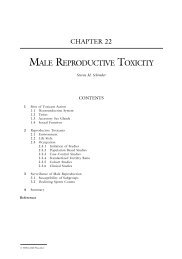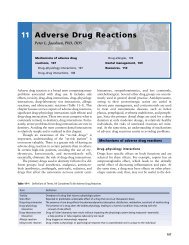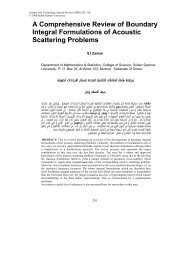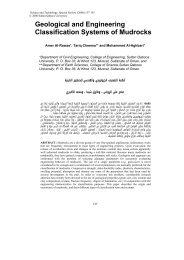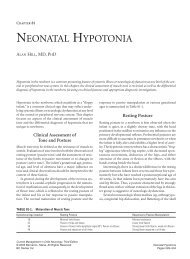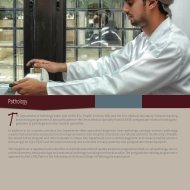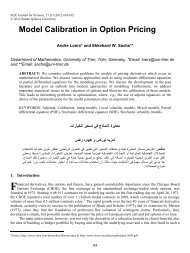(Solanum Tuberosum L.) grown in Oman - Sultan Qaboos University
(Solanum Tuberosum L.) grown in Oman - Sultan Qaboos University
(Solanum Tuberosum L.) grown in Oman - Sultan Qaboos University
Create successful ePaper yourself
Turn your PDF publications into a flip-book with our unique Google optimized e-Paper software.
ELSADIG A. ELTAYEB, SANA SALEM AL-SINANI and I.A. KHAN<br />
Glycoalkaloids are thought to function <strong>in</strong> the chemical defense of the plant, as nonspecific<br />
protectors or repellents aga<strong>in</strong>st potential pest and predators (Roddick, 1989). They are found<br />
throughout the potato plant with the highest levels observed <strong>in</strong> those parts of the plant with high<br />
metabolic rates (Van Gelder, 1990). Tubers have much lower glycoalkaloid content than foliage<br />
and the distribution is not uniform, with higher levels found <strong>in</strong> the periderm and cortex decreas<strong>in</strong>g<br />
markedly towards the pith (Dale et al. 1998). The majority of current commercial varieties have<br />
been reported to have their average GA content below 150 mg/kg fresh weight (FW) (Van<br />
Gelder, 1990). Concentrations <strong>in</strong> the range 10-150 mg/kg FW are regarded as acceptably low,<br />
while glycoalkaloid concentration exceed<strong>in</strong>g 200 mg/kg FW gives a bitter taste and can cause<br />
gastroenteric symptoms, coma, and even death (Gregory, 1984). Consequently potato tubers<br />
conta<strong>in</strong><strong>in</strong>g >200 mg glycoalkaloids kg -1 fresh weight exceed the limit recommended for food<br />
safety and should be withdrawn from sale (Percival and Dixon, 1994).<br />
The total glycoalkaloid level <strong>in</strong> potato tubers is controlled by genetic as well as<br />
environmental factors (Dale et al. 1998). Potato <strong>grown</strong> <strong>in</strong> <strong>Oman</strong> is faced with vary<strong>in</strong>g degrees of<br />
heat stress. Breeders have been screen<strong>in</strong>g potato varieties adapted to local conditions (Khan et al.<br />
2001, 2002).<br />
Potato glycoalkaloids represent a threat not only to certa<strong>in</strong> microbial pathogens and<br />
herbivores, but also to man if excessive quantities are <strong>in</strong>advertently <strong>in</strong>gested (Morris and Lee,<br />
1984).<br />
Because of the importance of glycoalkaloids <strong>in</strong> the quality of potatoes and their resistance to<br />
disease, the present <strong>in</strong>vestigation was undertaken with a view to f<strong>in</strong>d<strong>in</strong>g out the accumulation rate<br />
of glycoalkaloids <strong>in</strong> tubers exposed to postharvest stress such as mechanical damage and low<br />
temperature storage.<br />
Although the nature and relative concentrations of glycoalkaloids are genetically determ<strong>in</strong>ed,<br />
the total concentrations are certa<strong>in</strong>ly <strong>in</strong>fluenced by environmental factors dur<strong>in</strong>g the grow<strong>in</strong>g<br />
period (Friedman and McDonald, 1997). Elevated glycoalkaloid levels may be caused by adverse<br />
grow<strong>in</strong>g conditions such as prolonged cold, extreme heat, too much water, too little water, too<br />
much sunsh<strong>in</strong>e, or too little sunsh<strong>in</strong>e (Friedman and McDonald, 1997). Also glycoalkaloids,<br />
which are usually present at low levels <strong>in</strong> commercial potatoes, may accumulate as a result of<br />
cont<strong>in</strong>ued biosynthesis. Environmental and storage factors may <strong>in</strong>fluence glycoalkaloid formation<br />
(Friedman and McDonald, 1997).<br />
More glycoalkaloid concentrations were reported as a result of storage at lower temperatures<br />
than at higher temperatures by Griffiths et al. (1997). Any <strong>in</strong>jury or damage to the potato plant or<br />
tuber is thought to result <strong>in</strong> glycoalkaloid accumulation. Thus disease or <strong>in</strong>sect attack to the plant<br />
as well as rough tuber handl<strong>in</strong>g dur<strong>in</strong>g harvest or distribution will <strong>in</strong>itiate glycoalkaloid synthesis<br />
(Maga, 1994).<br />
2. Experimental<br />
Potato Samples: Seed tubers of 7 exotic potato varieties were harvested <strong>in</strong> mid March 2000<br />
and cold-stored up to mid October 2000. The plants were <strong>grown</strong> <strong>in</strong> two periods: the first from<br />
mid-November 2000 to mid-February 2001 and the second from mid-December 2000 to mid-<br />
March 2001 at the Agricultural Experiment Station, <strong>Sultan</strong> <strong>Qaboos</strong> <strong>University</strong>, Muscat, <strong>Oman</strong>.<br />
The plants were <strong>grown</strong> <strong>in</strong> sandy loam soil of 49% sand, 34% silt and 12% clay. Fertilizer<br />
was added as N:P:K <strong>in</strong> the ratio of 2:1:1 with N given as 224 kg ha -1 .<br />
Irrigation was scheduled accord<strong>in</strong>g to evapotranspiration data, which was averaged for 90<br />
days at about 51 m 3 d -1 ha -1 . Dur<strong>in</strong>g that period the total precipitation was 30 mm and the average<br />
day temperature was 31°C (overall average temperature was 21°C). The average relative<br />
humidity was 62% and the average day-length was 12.5 hours, with average total radiation of 16<br />
cal./hr.cm 2 (186 W/m 2 ). The average net solar radiation was 7 cal./hr.cm 2 (81.75 W/m 2 ).<br />
84





